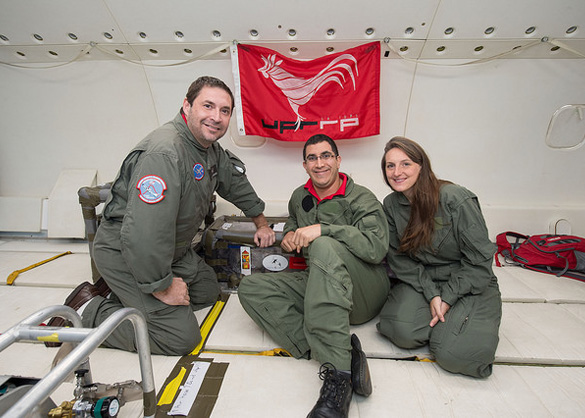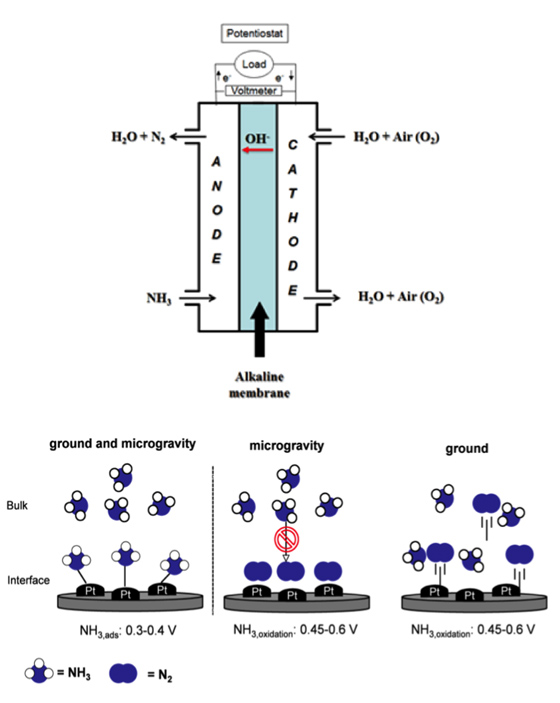On the performance of a nanocatalyst-based Direct Ammonia Alkaline Fuel Cell (DAAFC) under microgravity conditions for water reclamation and energy applications
PI: Carlos Cabrera, University of Puerto Rico - Rio Pedras, Harry Rivera (Co-I), Inter American University of Puerto Rico - Bayamon
PI: Carlos Cabrera, University of Puerto Rico - Rio Pedras, Harry Rivera (Co-I), Inter American University of Puerto Rico - Bayamon

- TA03 Space Power & energy Storage
- TA06 Human Health, Life Support and Habitation Systems
- TA08 Science Instruments, Observations and Sensor Systems
- TA10 Nanotechnology
The long-term goal of the proposed research is to develop and demonstrate a DAAFC using nano-based electrodes to enhance ammonia electrochemical decomposition for water reclamation and energy applications. This experiment will study the effects of microgravity on the performance of a DAAFC. Previous research campaigns (Micro-G CANM 1 and Micro-G CANM 2) have shown that a reduction in catalytic current of 20-65% occurs under microgravity conditions depending on the type of catalyst utilized. With the data obtained from these two campaigns the micro-g team is determining an optimized combination between catalyst structure, porosity and hydrodynamic turbulent mixing in order to scaleup to a fuel cell.
The proposed technology is considered to be at TRL 6 since this direct alkaline ammonia fuel cell demonstrates a sub-system prototype in microgravity. Microgravity is a relevant environment since the purpose of the system is to be useable in a space environment. We believe that after this flight campaign the proposed technology will be a TRL 7. This TRL maturation will provide the team the necessary platform to further increase the TRL to 8; after the correct sizing and performance tests in this
These test flights are a performance test of a Direct Alkaline Ammonia Fuel Cell, which is a critical element of the NASA Ames Forward Osmosis Secondary Treatment (FOST) system. After the requested flight opportunities the team will be able to develop the proposed technology to be finally integrated onto the FOST system at NASA Ames.
The rationale for the consecutive flights is: (1) obtain baseline data and optimize the electrochemical performance under microgravity conditions, (2) test of microgravity adapted catalysts in a DAAFC under operating conditions, (3) obtain reproducibility of results. In order to achieve the maturity of the technology, the team will fly four different single membrane ammonia fuel cells at different conditions in order to have a better understanding of its operation under microgravity conditions. This data will be used to scale up to a fuel cell stack (multiple membranes).
The basic setup of the equipment to be utilized for these experiments is already built and has been flown before for Micro-G CANM 1 and 2 campaings, it is called the Electrochemical Microgravity Laboratory (EML). The EML is comprised of 3 separate compartments and it is capable of performing four experiments at the same time. New adaptations to the system will allow the installation of four different direct ammonia alkaline fuel cell hardware, peristaltic pumps for liquid delivery and breathing air canisters to feed the cathode side of the fuel cell.
The Electrochemical Ammonia Removal (EAR) Subsystem is a Direct Ammonia Alkaline Fuel Cell (DAAFC) as shown in the upper image below. The lower image shows the Ammonia oxidation process in microgravity and ground.

Technology Details
-
Selection DateAFO5 (Jan 2013)
-
Program StatusCompleted
- 2 Parabolic
Development Team
-
PICarlos Cabrera
-
PI Organization
-
Co-IHarry Rivera
-
Co-I OrganizationInter American University of Puerto Rico - Bayamon
-
SponsorNASA/Ames Research Center
-
PartnersMichael Flynn
-
More Information

